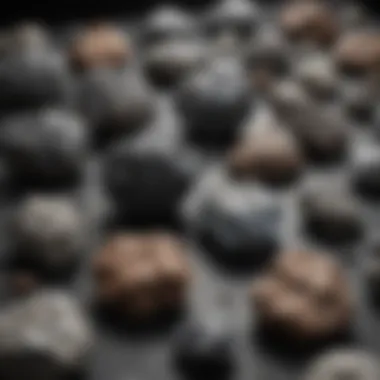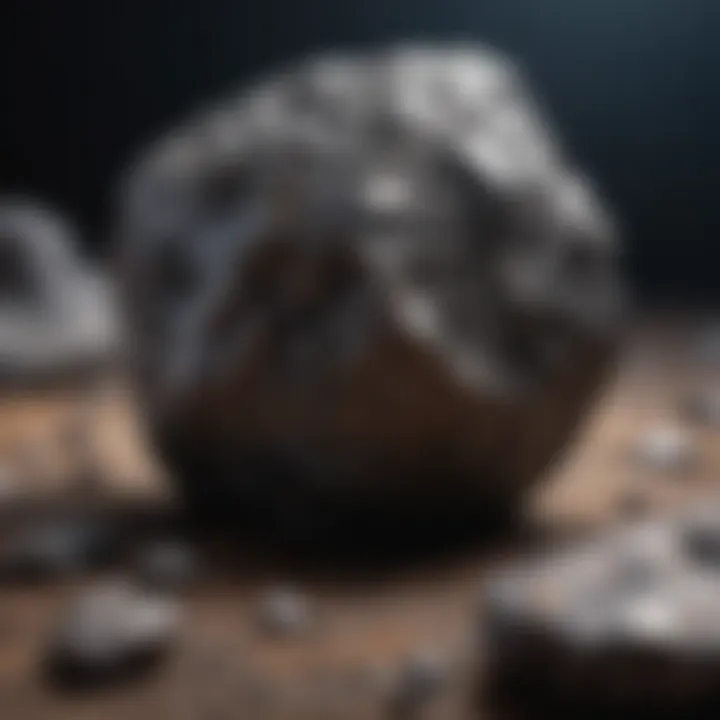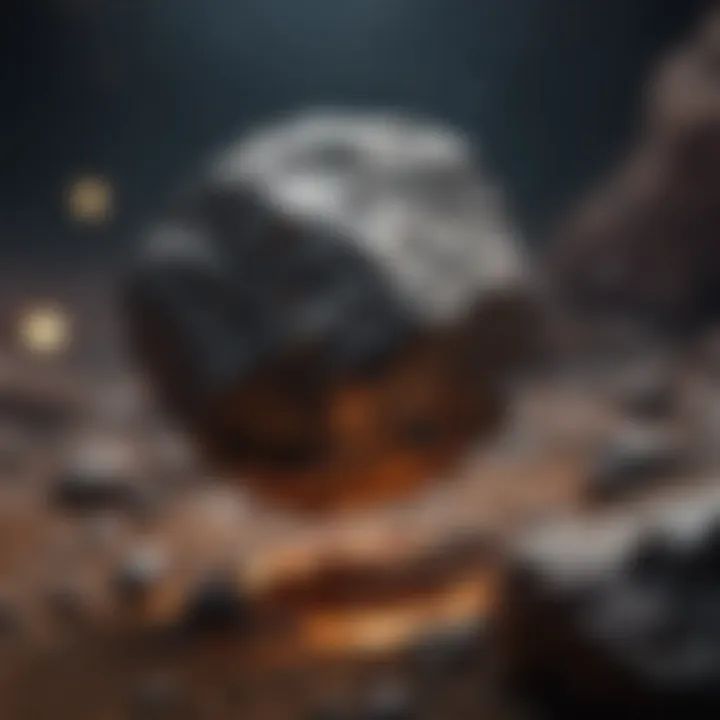Meteorites: A Deep Dive into Celestial Collectibles


Intro
Meteorites hold a unique fascination for both scientists and collectors. They are remnants of the universe, allowing us to glimpse the early solar system. With the right knowledge, enthusiasts can appreciate these celestial collectibles not just for their beauty, but for their scientific significance. Whether you're a seasoned collector or just beginning, understanding meteorites opens up a captivating world.
Featured Collectible of the Month
Overview
This month, we highlight the Allende meteorite. Falling in Chihuahua, Mexico, in 1969, it is classified as a carbonaceous chondrite. Its rich history and unique composition make it a favorite among collectors. The Allende meteorite has become crucial in studies of the solar system's formation, offering clues to the processes that shaped the planets.
Historical Significance
The Allende meteorite is notable not only for its age but also for its impact on science. It was the first meteorite observed to fall and then collected shortly after. This ensured that its condition remained excellent, allowing researchers to study it in detail. The connection to the solar system's early history is invaluable, offering insights into organic compounds present in the universe. Such attributes elevate its status within collections significantly.
Identification Techniques
Understanding how to identify meteorites is essential for collectors.
Visual Characteristics
Meteorites often display unique visual markers that differentiate them from terrestrial rocks. When examining a potential meteorite, consider the following:
- Fusion Crust: A shiny layer that forms when the meteorite enters the atmosphere.
- Chondrules: Small spheres found in some meteorites, indicating early solar system processes.
- Density: Meteorites generally have a higher density than regular rocks; utilize a balance scale for precise measurements.
Resources for Identification
Identifying meteorites may require support from various resources. For collectors looking to examine their finds further, here are some helpful resources:
- Wikipedia - Meteorite
- Britannica - Meteorites
- Reddit Meteorites Community
- Facebook Meteorite Collectors Group
Meteorites are not just rocks; they are pieces of history that tell the story of the cosmos.
By employing the right techniques and utilizing available resources, collectors can enhance their understanding and appreciation of meteorites. As you delve into the complexities of identification, your engagement with these celestial treasures will undoubtedly deepen.
Preface to Meteorites
Meteorites serve as a bridge between our world and the vast, unexplored realms of outer space. Understanding meteorites is not just an academic pursuit; it enriches our knowledge about the cosmos and its history. This section will discuss important aspects of meteorites, including what they are, where they come from, and their significance in both scientific study and collecting.
Definition and Origin
Meteorites are fragments of rock or metal from outer space that survive their journey through the Earth’s atmosphere and land on the planet's surface. They originate from a variety of celestial bodies, such as asteroids, the Moon, and even Mars. The classification of meteorites into stony, iron, and stony-iron types provides insight into their origins and compositions. Each type tells a unique story about the conditions and processes that existed in the early solar system.
The journey of a meteorite begins when a meteoroid, usually a small fragment of an asteroid, travels through space. When it enters Earth's atmosphere, it becomes a meteor in the sky. If it survives the fiery descent and lands on the ground, it is classified as a meteorite. This process not only highlights the physics behind celestial objects but also underscores the rarity of meteorites reaching Earth.
Historical Significance
The historical significance of meteorites cannot be understated. They have fascinated humans for centuries, often linked to myths, religious beliefs, and ancient cultures. For example, the ancient Egyptians viewed meteorites as divine objects. In modern times, significant meteorite falls have influenced scientific discoveries. The famous Allende meteorite, which fell in Mexico in 1969, has provided invaluable data on the early solar system, offering insights into the elemental composition and conditions of our planetary neighbors.
Beyond their scientific value, meteorites encourage curiosity and exploration. Collectors often seek these pieces of the cosmos for personal enjoyment as well as for investment potential. Understanding their history enhances their value, both monetary and sentimental.
"Meteorites not only tell us about the universe; they are artifacts of its early history, allowing us to glimpse a distant past."
Types of Meteorites
The study of meteorites reveals diverse classifications that shed light on their formation and significance. Understanding the types of meteorites is crucial for both collectors and scientists. Each type offers unique characteristics, historical insights, and implications for planetary science. Recognizing these categories enhances appreciation for their diversity and allows collectors to make informed decisions about their specimens.
Stony Meteorites
Stony meteorites, known as the most common type, consist mainly of silicate minerals. They are further divided into two main groups: chondrites and achondrites. Chondrites are particularly significant due to their ancient characteristics, preserving materials from the early Solar System. Chondrules, which are small, round particles found within chondrites, point to the processes that occurred during planetary formation.


Achondrites, in contrast, showcase more differentiated materials, indicating a history of melting and crystallization. With their varied mineral compositions, stony meteorites provide valuable insights into planetary evolution. For collectors, stony meteorites often occupy a central place due to their accessibility and broad spectrum of available specimens.
Iron Meteorites
Iron meteorites predominantly consist of iron-nickel alloys. They are fewer in number but have higher densities. Understanding their origin is critical as they primarily stem from the cores of differentiated planetary bodies. Their unique crystalline structures, such as Widmanstätten patterns, are visually striking and highlight their distinct formation processes.
Collectors often prize iron meteorites for their aesthetic qualities and rarity. Due to their historical and scientific importance, they often carry higher values in the market, particularly well-preserved specimens. Their metallic properties also make them interesting in various applications, from scientific study to artistic endeavors.
Stony-Iron Meteorites
Stony-iron meteorites represent a fascinating blend of stony and metallic components. This group includes two main classifications: pallasites and mesosiderites. Pallasites are known for their beautiful olivine crystals set in a metallic matrix, making them highly coveted among collectors.
Mesosiderites are more complex, displaying a combination of metallic and stony materials, indicating a more intricate history of formation. The unique characteristics of stony-iron meteorites make them a topic of interest in the study of planetary differentiation and impact processes. Collectors value them not only for their complexity but also for their rarity compared to the other types.
"Meteorites, whether stony, iron, or stony-iron, serve as time capsules of our Solar System’s history, each telling a different story of cosmic events."
Meteorite Classification
Meteorite classification is an essential aspect of understanding these celestial objects. It allows both scientists and collectors to categorize meteorites based on their composition, structure, and origin. This classification system helps in the identification of meteorites and aids in the scientific research that can influence our perception of the universe. Accurate classification informs enthusiasts about the rarity, value, and historical significance of different meteorite types.
Classifying meteorites into distinct categories not only enhances scientific communication but also provides collectors with essential knowledge on the types they may wish to acquire. Understanding these classifications can lead to better investment decisions and foster more meaningful connections with these extraterrestrial collectibles.
Chondrites vs. Achondrites
Chondrites and achondrites are the two primary classes of stony meteorites, each with unique characteristics. Chondrites contain round grains called chondrules, which formed as molten droplets in space before being incorporated into the parent body. They are the most common type of meteorite, making up about 85% of all meteorite finds. Achondrites, unlike chondrites, do not contain these chondrules. Instead, they have undergone differentiation and changes, usually related to planetary processes, which makes them less common.
The difference between these two classes is significant when examining the history of the solar system. Chondrites offer insights into the early solar nebula, whereas achondrites relate more to planetary bodies' geological processes. Recognizing these differences is critical for any serious collector or researcher.
Unique Classifications
Carbonaceous Chondrites
Carbonaceous chondrites are a notable subclass of chondrites, rich in carbon and various organic compounds. They are quite important in studies about the origin of life because they may contain amino acids and other organic molecules. Their presence in collections can be beneficial for individuals interested in this area of research. Additionally, carbonaceous chondrites can provide clues about the building blocks that formed the Earth and other celestial bodies. One unique feature of carbonaceous chondrites is their ability to retain water, which can be both an advantage and a disadvantage; while it makes them interesting for research, it also makes them more challenging to conserve because they can deteriorate over time if not properly stored.
Pallasites
Pallasites are another fascinating subgroup, distinguished by their beautiful olivine crystals set in a metallic matrix. They are considered one of the most visually striking types of meteorites and have garnered significant interest among collectors. The key characteristic of pallasites is their complex structure, which indicates that they formed at the core-mantle boundary of differentiated asteroids. This offers valuable insights into the processes governing the composition of planetary bodies. A unique feature of pallasites lies in their aesthetic appeal; they are often cut and polished for display purposes, making them highly sought after by collectors. However, their scarcity and higher prices can be a disadvantage for some.
Mesosiderites
Mesosiderites are another unique classification that merges features of both stony and metallic meteorites. They originate from bodies that experienced significant impact events, which led to the mixing of silicate materials with metal. This blending gives mesosiderites a heterogeneous appearance that can be quite intriguing. Mesosiderites are often seen as beneficial for collectors seeking unique pieces that tell stories of colliding cosmic events. The mix of materials in these meteorites can result in diverse textures and colors, making them desirable for display. However, their complex composition may pose challenges for classification and conservation efforts.
Formation and Journey to Earth
The journey of meteorites begins long before they enter Earth's atmosphere. Understanding the formation and subsequent journey of these celestial objects is essential for both scientists and collectors. It unveils the processes that govern the cosmos and provides insights into the nature of our solar system. This section discusses two critical aspects: the origins in the solar system and the entry into Earth's atmosphere.
Origins in the Solar System
Meteorites originate from various sources within the solar system. They can come from asteroids, comets, or even the Moon or Mars. Stony meteorites, for instance, primarily stem from the asteroid belt. These asteroids are remnants from the solar system's formation, composed of rock and metal. When collisions occur among these asteroids, fragments break off and can wander through space.
Another vital source is the lunar surface. Lunar meteorites provide invaluable information about the Moon's history and geology. Similarly, Martian meteorites have been discovered on Earth, offering clues about the Red Planet's past environment. Understanding where meteorites come from is fundamental because it allows scientists to piece together the history of planetary formation and the evolution of the solar system itself.
Entry into Earth's Atmosphere
As meteorites travel through space, they can eventually find their way into Earth's atmosphere. When a meteoroid, a small fragment of a comet or asteroid, enters our atmosphere, it encounters immense friction. This leads to a bright flash of light known as a "meteor" or "shooting star." The speed of entry and the size of the meteoroid determine whether it will survive this fiery descent.
Most meteoroids burn up before reaching the ground. However, larger ones may survive and land as meteorites. The speed at which these objects enter the atmosphere is typically about 11 to 72 kilometers per second, creating intense heat as they compress the air in front of them. Understanding how meteorites enter the atmosphere helps researchers study their characteristics, providing insights into their structure and composition.
"Meteorites are not just unique collectibles; they are messengers from our past, offering glimpses into the dawn of the solar system."
In summary, the formation and journey of meteorites are crucial aspects of their study. Recognizing their origins enhances our understanding of the solar system's evolution, while insights into their atmospheric entry explain the phenomena associated with meteor sighting. Collectors often value these pieces not only for their rarity but for the stories they tell about the universe.


Collection and Identification
Understanding how to collect and identify meteorites is crucial not only for enthusiasts but also for anyone interested in the science behind these celestial objects. The correct identification of meteorites can prevent collectors from being misled by earthly rocks or forged items. Experts often stress that a meteorite is not simply any stone that looks unusual; it must meet specific characteristics related to its composition and physical properties. Knowing the nuances involved in this process can greatly benefit the collector's experience, ensuring they build a genuine collection.
How to Identify a Meteorite
Identifying a meteorite involves observing several key features that differentiate it from ordinary rocks. Here are some critical aspects to consider:
- Exterior Appearance: Meteorites often have a dark, shiny surface known as fusion crust, resulting from their burning upon entering the Earth’s atmosphere. This crust may be smooth or textured, but it is a telling sign of a genuine meteorite.
- Density: Most meteorites have a higher density than terrestrial rocks. They often feel heavier than their size suggests, owing to their metallic or dense mineral content.
- Magnetism: Many meteorites contain iron and are magnetic. Using a magnet can help discern whether a rock might be a meteorite. However, not all meteorites are magnetic, so this is not an absolute criterion.
- Interior Characteristics: A section of a meteorite may reveal chondrules (small, round particles) in the case of chondrites. Crystals or a metallic shine are also indicators of meteorites.
Before concluding that you have found a meteorite, it can be beneficial to consult local experts or refer to resourceful communities. Online platforms such as reddit.com/r/Meteorites can provide insights through discussions with other collectors.
Collection Strategies
Collecting meteorites can be as thrilling as it is educational. Here are some useful strategies for collectors:
- Research Locations: Familiarize yourself with areas known for meteorite falls or finds. Places such as the Sahara Desert or Antarctica have become popular due to their conducive environments for discovering meteorites.
- Join Collecting Clubs: Consider joining meteorite collecting clubs or societies which often provide resources, workshops, and shared experiences. Being part of a community can enhance your skills and knowledge.
- Attend Shows and Auctions: Participate in mineral and fossil shows where meteorites are displayed and sold. This can also help establish relationships with reputable dealers.
- Verification: Always verify the authenticity of a meteorite before adding it to your collection. This can be achieved through tests or by consulting with established experts to avoid fraud.
Collecting meteorites transcends simple ownership; it fosters a connection to the cosmos and allows individuals to preserve pieces of history that unveil secrets about our universe.
Importance of Meteorites in Science
Meteorites hold significant value in the realm of scientific research. They serve as time capsules that provide insights not only into the history of our solar system but also into the processes that shaped planetary bodies. Observations and studies revolving around meteorites help scientists to answer a myriad of questions regarding planetary formation and evolution.
Understanding the Early Solar System
Meteorites act as remnants of the early solar system, dating back to its formation over 4.6 billion years ago. These celestial fragments can offer clues about the conditions that prevailed during that time, including the temperature, pressure, and chemical composition of the primordial solar nebula.
Chondrites, a common type of stony meteorite, contain small spherical particles called chondrules. Studying these gives insights into processes like the cooling and solidification of materials as the solar system formed. The isotopic analysis of these meteorites helps scientists to refine models of solar system evolution, underscoring how elements interacted in the nascent stages of planetary formation.
Investigating meteorites offers a glimpse into the early history of Earth, as some of these materials may have contributed to the planet's formation. Thus, they support our understanding of how Earth’s own structure and atmosphere developed, revealing fundamental data that could inform us about potential life-sustaining conditions on other planets.
Insights into Planetary Formation
Meteorites also provide valuable insights regarding the formation of terrestrial planets. The composition and structure of different meteorites correspond closely with the materials found on planets like Earth, Mars, and even the Moon. This relationship allows scientists to extrapolate how similar processes might have occurred on these celestial bodies, thus enhancing our understanding of their geological history.
For instance, studies of stony-iron meteorites, which are a blend of silicate minerals and metal, can illustrate the processes of differentiation that planets underwent—where heavier materials sank towards the core while lighter materials formed the crust. These findings can lead to comprehensive models that not only explain our own planet but potentially alien worlds as well.
“Meteorites are crucial for piecing together the jigsaw puzzle of the solar system's formation.”
All these aspects contribute to a broader perspective on how life might emerge elsewhere and how the existing planets have evolved over time. By studying meteorites, we uncover the mysteries of planetary formation and the very fabric of our cosmic neighborhood.
Meteorite Values and Market Trends
Meteorite values fluctuate based on various factors. This section examines crucial elements that impact these celestial collectibles' worth in the market. A clear understanding of these factors can greatly benefit both seasoned collectors and newcomers.
Factors Influencing Value
The value of a meteorite is determined by several key factors:
- Rarity: Some meteorites are extremely rare. Their scarcity can drive up demand and, subsequently, price. For example, the Allende meteorite, known for its carbonaceous chondrites, is more valued due to its unique composition and limited finds.
- Condition: The physical state of a meteorite significantly impacts its value. Those exhibiting minimal weathering or breakage are typically more desirable.
- Type: Different types of meteorites possess varying values. Iron meteorites often demand higher prices compared to stony types because of their aesthetic appeal and rarity.
- Provenance: The history and documentation of a meteorite's discovery can establish authenticity and increase its market value. Meteorites from famous falls, like the Chelyabinsk, tend to fetch higher prices.
- Scientific Significance: Meteorites that provide valuable insights into planetary formation or contain unique isotopes can accrue added value within scientific communities.
Understanding these factors allows collectors to make informed decisions when acquiring or selling meteorites.
Buying and Selling Meteorites
Entering the meteorite market requires diligence and knowledge. Here are some practical aspects to ponder:
- Research: Familiarize yourself with reliable sources. Websites like en.wikipedia.org and britannica.com offer valuable information on types and classifications of meteorites.
- Marketplace: Various platforms exist for buying and selling, such as auctions, online marketplaces like eBay, and specialized dealer websites. Engaging with communities on reddit.com or facebook.com can also provide insights and recommendations.
- Authentication: Engage with reputable dealers or gemologists for verification. Authenticity certifications can greatly enhance resale value.
- Pricing Trends: Track price movements in meteorite sales. Visiting collector forums can yield helpful insights into ongoing market trends.
- Documentation: Retain clear records of purchase, including where and how the meteorite was obtained. This may aid in proving authenticity should you decide to sell.


A well-documented meteorite with credible provenance often commands a substantial price in the collector’s market.
In summary, both the values and market trends of meteorites require close attention. With proper understanding and engagement in the right circles, collectors can navigate this niche market effectively.
Legal and Ethical Considerations
Understanding the legal and ethical dimensions of meteorite collecting is crucial for both enthusiasts and serious collectors. This aspect ensures that one respects existing laws while promoting responsible behavior. It is not only about possessing these celestial objects but also about understanding the implications that come with ownership. This section discusses meteorite ownership laws, as well as the ethics surrounding the collection of these extraterrestrial artifacts.
Meteorite Ownership Laws
Meteorite ownership laws can vary significantly across different countries and regions. In many places, the laws state that meteorites found on private land belong to the landowner. Meanwhile, the situation becomes more complex when meteorites land in public areas or in protected regions. For instance, in the United States, the National Park Service prohibits the collection of meteorites within national parks and other protected areas.
In countries like Australia, laws may enforce that any meteorites found are reported and registered with authorities. Knowing these regulations is critical for collectors to ensure they do not violate any laws.
Collectors can greatly benefit by familiarizing themselves with local laws regarding meteorite possession and collecting. Ensuring compliance protects both the collector and the broader community.
Ethics of Collecting
The ethics of meteorite collecting emphasize the moral responsibilities that collectors have towards natural history, science, and cultural heritage. As meteorites are valuable not just in monetary terms but also in terms of scientific information, it is essential to consider where and how they are sourced.
- Respect for Source: Collectors should ensure that their pieces come from reputable sources. This means acquiring meteorites that are legally obtained and ethically sold.
- Avoiding Exploitation: It is important to avoid supporting illegal excavations or collections from sensitive areas. Such actions can cause irreversible damage to the environment and dilute important scientific research opportunities.
- Contribution to Science: Engaging with scientific communities by sharing findings is commendable. Collectors are encouraged to connect with researchers or institutions that can help analyze their collections.
The ethical considerations in collecting meteorites can significantly impact the field. Respecting origins and legality benefits all.
Cultural Impact of Meteorites
The cultural significance of meteorites stretches across various domains, including history, mythology, and modern-day references. They are not merely cosmic rocks; these celestial bodies represent humanity's fascination with the universe. They provoke thoughts about origins, existence, and our place among the stars. By understanding the cultural impact of meteorites, one can appreciate the broader implications they have had on society, science, and belief systems.
Meteorites in History and Mythology
Throughout history, meteorites have intrigued cultures worldwide. Many ancient civilizations viewed these celestial objects as divine omens or symbols of change. The Greeks, for instance, believed meteors were messages from the gods. Similar beliefs prevailed among various cultural groups, where meteorites were often integrated into religious or spiritual practices. For example, in Japan, the Kōanshi, or "document of a falling star," were often revered and seen as harbingers of luck.
In addition, several meteorites have been given notable names, which echo their journey through both the cosmos and human civilization. The famous Hoba meteorite in Namibia is one of the largest known meteorites on Earth and has become a national treasure, mingling scientific curiosity with local pride.
These artifacts support not only scientific understanding but also emotional and psychological connections to myths and stories that define cultural identity. They bridge the realms of science and spirituality, showing how people have sought meaning in the mysteries of the universe.
Modern Cultural References
Meteorites continue to leave a mark on contemporary culture. They feature prominently in literature, film, and art. The symbolism attached to meteorites resonates in countless stories about creation, transformation, and periods of chaos. The striking nature of meteorites captivates filmmakers, contributing to narratives surrounding extraterrestrial life and cosmic events.
In literature, meteorites often symbolize sudden change or revelation. For instance, works of science fiction frequently utilize meteorites as plot devices that open new worlds or bring forth ancient knowledge. Moreover, they symbolize humanity's relentless pursuit of exploring beyond the Earth.
Further, meteorites have found their way into merchandising and pop culture. Items made from genuine meteorite material are sold as jewelry or collectibles. Such objects serve both aesthetic and scientific purpose, appealing to collectors and enthusiasts alike. The ability to own a piece of the cosmos embodies a sense of connection to the universe and its mysteries.
"Meteorites are not just fragments from space; they embody thousands of years of human fascination and cultural significance."
Collectively, the cultural impact of meteorites illustrates how our understanding of these celestial objects informs both our historical narratives and modern-day interpretations. They symbolize humanity's quest for knowledge and the deep-rooted belief that the cosmos holds answers to our most profound questions about life and existence.
Epilogue
The conclusion serves as a significant summation of the various topics discussed in this comprehensive guide to meteorites. It connects the dots between science and collecting, presenting a holistic view of the subject. Understanding meteorites involves both appreciation of their scientific relevance and insight into their collector's appeal. Through this article, readers will recognize that meteorites are not merely rocks from space, but pivotal pieces in the puzzle of our solar system’s history.
The Future of Meteorite Studies
The future of meteorite studies looks promising. Research methods are advancing, allowing scientists to analyze these celestial objects in greater detail. More sophisticated technology, such as advanced imaging techniques, will enable deeper insights into the chemical composition and age of meteorites. With ongoing missions to asteroids and other celestial bodies, more samples will be brought back to Earth, enhancing our understanding of planetary formation.
Moreover, interdisciplinary approaches that unite geology, astronomy, and even art can provide new perspectives on how meteorites influence our planet and culture. Collaborative efforts among scientists and enthusiasts will inspire innovative research and preservation efforts. The study of meteorites is not static; it evolves with every discovery.
Final Thoughts on Collecting Meteorites
Collecting meteorites goes beyond mere hobby; it is an expedition into the unknown. The thrill of discovering a piece of space that has traveled vast distances can be deeply fulfilling. When engaging in meteorite collection, it is essential to keep several factors in mind. First, ensure that your collection complies with local laws and ethical standards. Resources like the Meteoritical Society can provide guidance.
Additionally, developing an understanding of the market and the value of different types of meteorites will aid in becoming a well-informed collector. Rare specimens can be valuable, both scientifically and financially, but the joy of collection should not be overshadowed by the pursuit of profit. Being careful about provenance and documentation will enhance the credibility and enjoyment of your collection.
In summary, whether you aim for scientific exploration or personal satisfaction, meteorites offer a unique connection to the universe. They serve as reminders of our cosmic origins and the wonders of space.
"Meteorites are not just collectibles, they are the storytellers of our solar system."
As collectors and enthusiasts embrace the future of meteorite studies, they contribute to a growing appreciation of these remarkable celestial objects.
By understanding the scientific significance and ethical considerations of meteorite collection, enthusiasts can ensure a meaningful journey into the cosmos.



